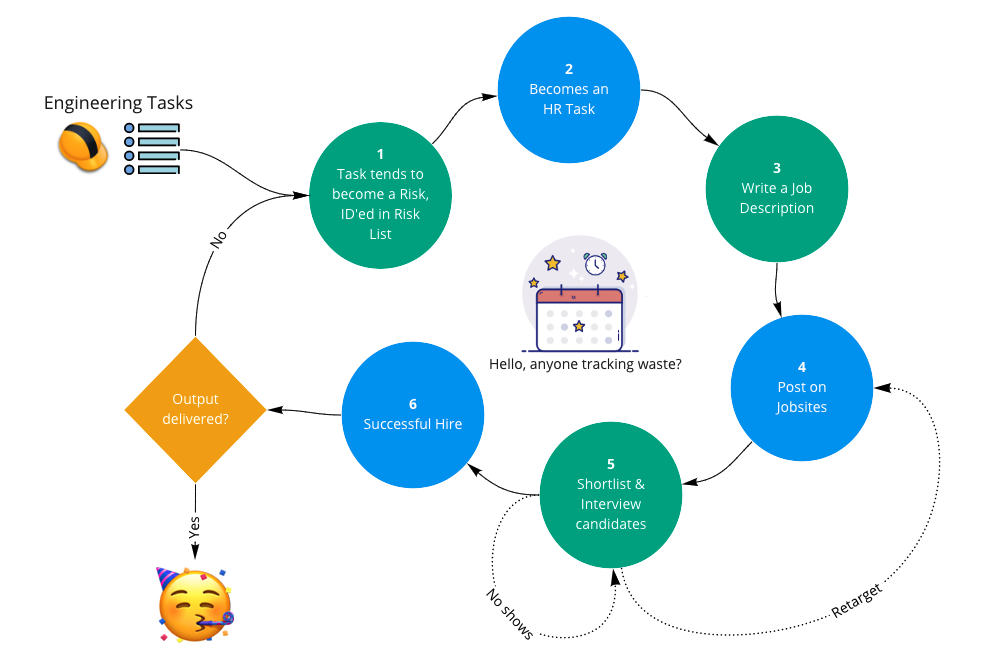As an engineering or R&D manager you’re facing issues in resourcing (finding the right talent to work on a task) all the time. This is especially true if you work for a small or medium company as there is a war out there for the right talent. But it becomes even more difficult when the task is dependent on hyperspecialized resources who are not available at short notice.
Tasks instead of jobs
I mention tasks here on purpose (instead of jobs) because we’re not looking for someone to work, we want to get results.
So what is a task? The classical (Merriam Webster’s) definition is:
- a usually assigned piece of work often to be finished within a certain time
- something hard or unpleasant that has to be done
- duty, function
Tasks are important because they’re something engineers do every day. Engineering managers maintain tasks as a set of to-do’s which their engineers execute on a timely basis. Converting hand markup to AutoCAD, design 10 circuits, and whatnot…
When a task becomes a problem
Most of the time, the execution runs smoothly. But sometimes, it so happens that a task starts to become a risk, which – if left unmanaged – results in an economic loss for the organization.
We see it happening all the time. You could even say that the problems with tasks usually follow a typical lifecycle.

Phase 1: Shape-shifting task to risk
This is the moment when there is a “shape-shifting” of the task. Depending on the complexity or criticality to the business the task becomes a risk. The usual culprits are:
- non-availability of an engineer to do a task
- un-availability of the right skills to do a task
- getting the task done within a budget
- inability to get a task done while ensuring the right output
Our specific area of interest is to look at those tasks that have a high tendency to become risks in the project. Most engineering managers would remember an internal/external auditor nudging you to identify them proactively early on (even during the project planning stage) and add them to the risk list.
Phase 2: Ownership shifting
Given the above situation, panic sets in, the immediate reaction is to identify the most helpful resourceful person to address the risk. Now after shape-shifting, the task starts to exhibit another complex character, i.e “Ownership shifting”.
The ownership of the task moves to HR. Big sigh of relief for the engineering manager! Most often the mandate given to HR is to hire someone who can do this job on a temporary basis (freelancer/part-time etc.).
Phase 3: Job (not task!) description
No sooner than the baton is passed to HR, the engineering manager gets the baton back. Now, the hiring manager (one who has the pain) has to write a job description, typically covering the engineering roles & responsibilities.
Phase 4: Vetting candidates
The task now becomes a job that gets posted on multiple job sites and candidates start applying. Though the ownership is now on HR & the hiring manager to vet each one of the applications, in reality, it rests mostly with the engineering manager. As expected, managers realize that what you see in the CV is not what you get (WYSINWYG). The hunt continues…
Phase 5: New owner of the task
After an arduous rollercoaster ride, a candidate is selected, but with no guarantee for output. The organization ends up paying for hours and not the result. Luckily the task now has a new owner and moves away from the risk list back to engineering To-Do’s. Sigh of relief for everyone involved and life is back to normal.
Hiring vs solving engineering problems
Imagine this being the plight of one engineering manager, the scale could be much bigger when it comes to larger organizations. This is where the economic value of getting things done matters. The system is broken.
Today engineering managers are hiring rather than focusing on solving problems. This is why Tasker matches engineers with engineering tasks. We encourage the companies we work with to think in terms of desired output, what deliverables they need. We then find the person with the skills that are required to solve this problem and deliver the task successfully.
Just like software, other areas in engineering are also catching up fast in looking at efficient ways for teams to organize & engineer together, aided by the advent of platforms like Onshape and OneIPM. The time has come for engineering managers to embrace change and build on the latest developments in this area.
And don’t let potential issues with important tasks surprise you. Be prepared! Check out the self-assessment you can do for your current engineering tasks that I shared in another post.
Need help getting engineering tasks done?






